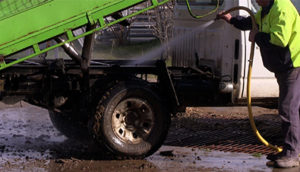Read the latest information on
Foot-and-mouth disease
 While the movement of livestock is the most likely pathway for spreading animal diseases and pests and weeds throughout Australia, people, vehicles and equipment can also act as vectors for many endemic and exotic biosecurity threats.
While the movement of livestock is the most likely pathway for spreading animal diseases and pests and weeds throughout Australia, people, vehicles and equipment can also act as vectors for many endemic and exotic biosecurity threats.
With the recent announcement by the Queensland Government that accredited lay people will be permitted to provide pregnancy testing services to the cattle industry, Animal Health Australia (AHA) are reminding livestock producers to be aware of the biosecurity risks when dealing with consultants and service providers who may be travelling from property to property for their work.
“Vets, stock agents, transporters, agronomists and other service providers are vital to the success of our agricultural industries,” said Dr Simon Humphrys, Executive Manager of Biosecurity and Product Integrity at AHA.
“While the vast majority of these professionals know the risks their work can pose and take those risks seriously, it pays for you as a livestock producer to be aware of who is coming onto the property and the circumstances in which they may be coming into contact with your livestock.”
Clothing, boots, tire treads and equipment can become contaminated with disease agents or weed seeds, while many insect pests are known to hitch rides in the undercarriages of vehicles or within containers.
When people, vehicles and equipment move from property to property, those contaminants can be carried with them, making biosecurity an important barrier for preventing big problems from spreading.
“Thankfully, many of these risks can be handled by the simplest of biosecurity measures – the ‘come clean, go clean’ philosophy,” Dr Humphrys explained.
“Practising basic hygiene, decontaminating equipment and, where practical, washing down vehicles can have an immense impact on the spread of contaminants and contagions.
“Better yet, where practical, provide guests that are going into production areas on your property with dedicated gear like overalls, boots, vehicles etc so you have greater control over routes of entry for risks.”
Other strategies, such as providing visitor parking and clearly marking clean and ‘dirty’ zones via signage, can help prevent problems before they’re had a chance to establish. Meanwhile, keeping accurate records of visitors movements – along with new livestock and plant purchases and consignments of supplies – can help to trace an issue to its source.
“Livestock producers will always need specialist providers like vets to come onto their properties to keep the show running, but they can reduce risks,” Dr Humphrys said.
“We encourage you to work with your consultants and service providers – as you would with utility companies and others who may access the property but not necessarily come into contact with your livestock – on developing a biosecurity strategy that works for both parties.”
Find out more about biosecurity for people, vehicles and equipment on the Farm Biosecurity website